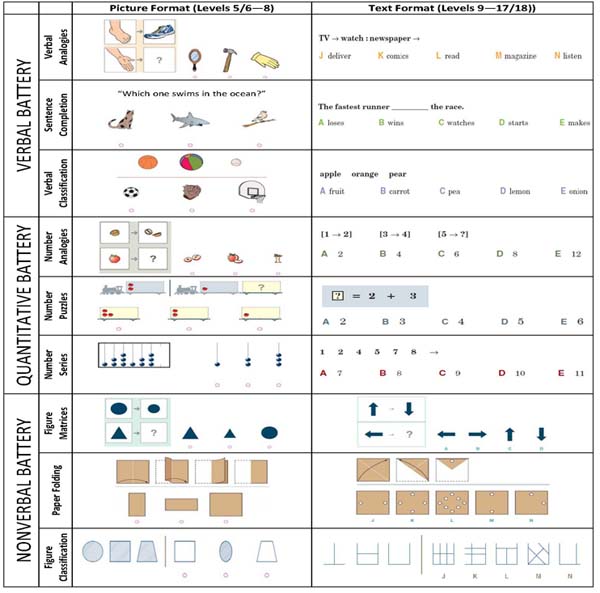- CogAT 7
- Overview
- Sample Reports
- Time Tables
- Glossary
COGNITIVE ABILITIES TEST™ - OVERVIEW
The Cognitive Abilities Test™ (CogAT®) provides a comprehensive view of students’ abilities. CogAT is a group-administered assessment of students’ learned reasoning and problem solving abilities in three areas: verbal, quantitative, and nonverbal. The current version, CogAT Form 7, reflects current industry research in the measurement of cognitive abilities and learning styles. The assessments are well-suited to help educators make important student placement decisions, such as selecting students for gifted and talented programs.
Lead author Dr. David F. Lohman is an internationally recognized abilities assessment researcher and winner of the National Association of Gifted Children's Paper of the Decade award. In CogAT Form 7, he has built on the strengths of the assessment by introducing a variety of enhancements, including new item types and a reduced language load to make the assessment even more appropriate for students who are learning English.

The reasoning abilities measured by CogAT are critical for success in school at all levels. Score reports describe the level and pattern of each student’s developed reasoning abilities.
BENEFITS
- Proven by research studies to identify more English Language Learners and minority students as possibly eligible for gifted and talented programs
- Form 7 updates make the assessment even more fair to students acquiring English
- A comprehensive ancillary package that provides guidance to educators so that they may make the most out of the assessment data
- Exclusive Ability Profile System provides insights into the way different students learn, and links assessment results to classroom instruction
- Technically superior instrument for screening students for school programs
- Authored by Dr. David Lohman (professor emeritus, University of Iowa), winner of the National Association for Gifted Children's Paper of the Decade award
TESTS
Reasoning abilities have substantial correlations with learning and problem solving, both within and outside of school. CogAT’s measurement of three different content domains ensures that educators receive a balanced view of each child.
Each level of CogAT offers three test batteries, each with multiple subtests:
Verbal
- Verbal Analogies (Picture format for Levels 5/6-8; text format for Levels 9-17/18)
- Verbal Classification
- Sentence Completion
For the Primary Edition, Picture Analogies and Picture Classification subtests are comprised of all picture-based items which tap into verbal reasoning processes without tying items to a specific administration language. Only the Sentence Completion test requires teacher-read prompts. On this subtest, children listen to the teacher read a question and then choose the picture that best answers the question. The new picture-based item formats on Picture Analogies and Picture Classification reduce the language load of the tests.
For the Multilevel Edition, the student must read individual words on two subtests of the Verbal Battery (Verbal Analogies and Verbal Classification) and a sentence on the third (Sentence Completion).
Quantitative
- Number Analogies
- Number Puzzles
- Number Series
The three subtests have been adapted for young students by couching quantitative reasoning challenges in engaging and accessible formats. The Number Analogies task for primary children relies on picture-based quantitative concepts rather than numeral representation. The Number Puzzles task presents equations as trains that must carry the same number of objects. And, finally, the Number Series task is presented as an abacus toy on which students search for patterns. All of these formats have been extensively tried out with students and have been found to engage students by tapping into important quantitative reasoning skills.
Nonverbal
- Figure Matrices
- Paper Folding
- Figure Classification
The three subtests at the Primary level are just like those at the Multilevel and did not require much adaptation for young students. The Figure Matrices subtest contains three figures in an analogy (A→B: C→⟨) that the student must complete. Paper Folding requires the examinee to determine how a folded, hole-punched paper will appear when unfolded. Figure Classification presents three figures in the stem, and the examinee is required to determine a fourth figure that belongs to the set.
Materials adapted from Riverside Insights' website with permission of the publisher. © 2016 by Riverside Insights. All rights reserved.